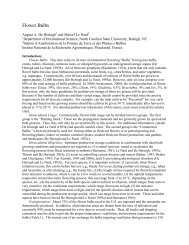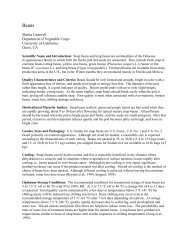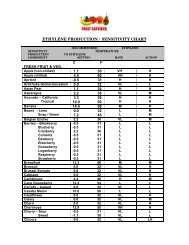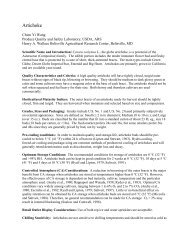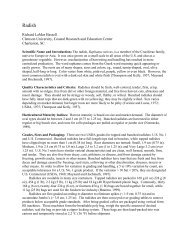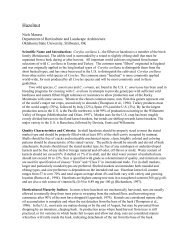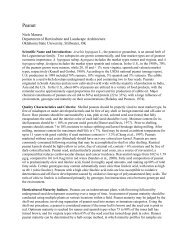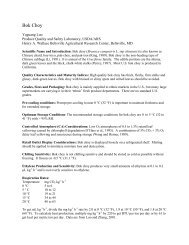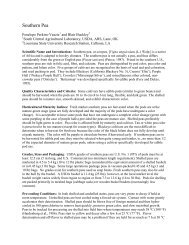Coconut
Coconut
Coconut
- No tags were found...
Create successful ePaper yourself
Turn your PDF publications into a flip-book with our unique Google optimized e-Paper software.
<strong>Coconut</strong>Robert E. Paull 1 and Saichol Ketsa 21 Department of Tropical Plant and Soil Sciences, University of Hawaii at Manoa, Honolulu, HI2 Department of Horticulture, Kasetsart University, Bangkok, ThailandScientific Name and Introduction: <strong>Coconut</strong> (Cocos nucifera L.) is marketed at two stages ofdevelopment. At an immature stage, the fruit (water coconut) contains mainly water and a little jelly-likemeat instead of the hard white flesh (meat - endosperm) found in mature coconuts. In Thailand, and nowmarketed in the US, immature green nuts are trimmed and shaped, removing most of the husk. The finalproduct has a flat bottom, round body with a pyramid top and the eyes showing. To prevent browning ofthe remaining husk, nuts are dipped in 1 to 3% sodium meta-bisulfite for 2 to 5 min and then wrapped inplastic film (Tongdee et al., 1991). Sometimes fungicide is included in the sulfite solution. Alternatively,the husk is removed before dipping in sulfite solution. Fruit are available year-round from most tropicalcountries (Seelig, 1970).Quality Characteristics and Criteria: Maturity, size, freedom from blemishes, cracking, freedom fromfiber of husked coconuts, and wet or moldy eyes are major quality characteristics. Check for a sloshingsound for presence of coconut water in the nut. <strong>Coconut</strong> milk is obtained by removing and grating thehard white flesh and squeezing out the milky juice. Immature, de-husked coconuts are about 10 cm (4 in)in diameter, weigh about 500 g (1.1 lb), have 100 g (3.5 oz) endosperm, 120 g (4.2 oz) shell and 250 g(8.8 oz) water.Horticultural Maturity Indices: Young coconuts are harvested 6 to 9 mo after flowering, as the nutapproaches full size and the skin is still green (Consignado et al., 1976; Srivichai, 1997) and the shortstem (rachillae) on the top of individual coconuts that originally held the male flowers (in Thai called‘rat-tail’) becomes half green and brown. In immature nuts, the skin surface around the calyx (cap) on thetop of coconuts is creamy-white or a whitish-yellow. When the area surrounding the cap is green thecoconut is regarded as mature and is 10 to 12 mo old. At maturity the skin begins to change from greento yellow then brown and the ‘rat-tail’ is entirely brown.Grades, Sizes and Packaging: No specific grades, informal grades usually based on size and weight.Mature US de-husked coconuts are sold in 34 to 36 kg (75 to 80 lb) woven plastic or burlap sackscontaining 40 to 50 coconuts, plastic mesh bags of 12 coconuts or cartons with 20 to 25 film wrappedcoconuts, 17 to 18 kg (37 to 40 lbs). Immature coconuts (water coconut) After the husked immaturecoconuts are shaped, dipped in bisulphate, and film wrapped, they are sold in single piece cartonscontaining 10 to 16 nuts. For young coconuts, the entire husk is removed and they are then dipped insodium bisulfite before packing.Pre-cooling Conditions: Room-cooling is generally used for mature husked nuts. Forced-air and hydrocoolingare acceptable. A rapid temperature change of 8 ºC (14.4 °F) can cause cracking.Optimum Storage Conditions: Mature coconuts with husk can be kept at ambient conditions for 3 to 5mo before the liquid endosperm has evaporated, the shell has cracked because of desiccation or sproutinghas occurred. Storage at 0 to 1.5 ºC (32 to 35 ºF) and 75 to 85% RH is possible for up to 60 days formature, dehusked coconuts (Maliyar and Marar, 1963) and 13 to 16 ºC (55 to 60 ºF) and 80 to 85% RHfor 2 weeks or less. Low RH and high temperature should be avoided.Young coconuts are normally held at 3 to 6 ºC (37 to 43 ºF) with 90 to 95% RH, while wrappedshaped fruit can be held for 3 to 4 weeks. Shaped young coconuts treated with 0.5 to 1.0% sodium meta-
isulfite, can be held at ambient temperature for 2 days before browning occurred, while those treatedwith 2% sodium meta-bisulfite can be held at ambient temperature for 2 to 7 days (Tongdee et al., 1992).Young coconuts that have not been dehusked can be stored for a longer period than de-husked or shapedyoung coconut. In de-husked or shaped coconut, SSC declines and TA increases more rapidly than innon-dehusked coconut, subsequently the taste of dehusked or shaped coconuts sours earlier than nondehuskedduring storage (Somboonsup, 1985). The husk acts as insulator and may increase the storagelifeof young coconuts.Controlled Atmospheres (CA) Consideration: No data are available on CA storage. Mature dehuskedcoconuts are waxed or film-wrapped to reduce water loss. Immature husked nuts can also be filmwrappedor waxed, however the outside color changes rapidly from white to brown unless dipped intosodium bisulfite (Tongdee et al., 1992).Retail Outlet Display Considerations: Display at ambient temperature and do not mist. Non-wrappedor individually-wrapped shaped coconuts are displayed at ambient temperature or 10 °C (50 °F).Sometimes, 5 to 10 shaped coconuts are placed in perforated polyethylene bags and sold in Thai retailmarkets.Chilling Sensitivity: When stored at 0 °C (32 °F), immature nuts have green skins that turn brown after7 days; few other changes occur in other quality characteristics at this temperature (Consignado et al.,1976).Ethylene Production and Sensitivity: Very low to near zero for mature husked coconut. There are noreports of sensitivity to ethylene.Respiration Rates: Mature husked coconuts respire at 45 to 55 mg CO 2 kg -1 h -1 at 25 °C (77 °F).This is equivalent to about 26 to 32 µL CO 2 kg -1 h -1 . To calculate heat production, multiply mg CO 2 kg -1h -1 by 220 to get BTU per ton per day or by 61 to get kcal per metric ton per day.Physiological Disorders: Mechanical damage to immature coconut will cause the white coir to turnbrown and can cause nut cracking. Younger nuts have a lower rupture force than mature nuts (Tongdee,1991). A rapid temperature change of 8°C (15 °F) during storage of mature husked coconut can lead tocracking (Burton,1982), while freezing occurs at -3 °C (26.6 °F). Moisture loss causes a loss of water inthe nut that can be reduced by RH control, film wrapping or waxing mature nuts.Postharvest Pathology: Superficial mold growth does occur on wet coconuts.Quarantine Issues: None, if mature, free of surface insects and soil, and the husk is dry. Somerestrictions exist on the importation into certain tropical and subtropical areas from countries havingdiseases that may impact local palms.Suitability as Fresh-cut Product: Meat from both immature (jelly-like) and mature (hard) is sold intrays with over-wrap or plastic bags for use in deserts. Immature coconut jelly-like meat and coconutwater have to be held at 3 to 5 °C (37 to 41 °F) to avoid spoilage. Small plastic bags with the jelly likemeat and water are frequently seen held on ice in South-East Asian Markets and at road-side stalls. Formature coconuts, non-shredded and shredded meat is packed in plastic bags for cooking and deserts.Special Considerations: None.References:
Burton, B.D. 1982. Prevention of postharvest studies cracks in husked coconuts during transit. J. Amer.Soc. Hort. Sci. 107:905-907.Consignado, T.O., P.C. Tabora and R.P. Creencia. 1976. Physio-chemicals changes in stored youngcoconut. The Phillipine Agriculturist 60:256-270.Marar, M.M.K. and C.A. Kurhiraman. 1957. Studies on the keeping quality of ripe coconut in storage.<strong>Coconut</strong> J. 10(4):37-51.Muliyar, M.K. and M.M.K. Marar. 1963. Studies on the keeping quality of ripe coconuts in storage.Indian <strong>Coconut</strong> J. 17:13-18.Seelig, R.A. 1970. <strong>Coconut</strong>s: Fruits and vegetable facts and pointers. United Fresh Fruit and VegetableAssoc., Wash. D.C.Somboonsup, S. 1985. Effect of some postharvest handling on quality of fresh coconuts. UndergraduateSpecial Project. Dept. Hort., Kasetsart Univ., Bangkok. 18 pp. (Thai)Srivichai, S. 1997. Planting <strong>Coconut</strong> Palm. Agric. Com. Pub., Bangkok, Thailand, 95 pp. (Thai)Tongdee, S.C. 1991. Postharvest handling of tender coconut. ASEAN Food J. 6:74-75.Tongdee, S.C., A. Suwanagul and S. Neamprem. 1992. Control of browning in trimmed green coconuts.In: ACIAR Project 8844, Wkshp Postharv. Hand. Trop. Fruit. Bangkok, Thailand, pp. 15.



